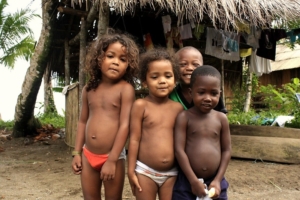Poverty in Colombia’s Chocó Region
 Chocó, Colombia’s poorest region, has long been a victim of ongoing conflict, corruption and racism, resulting in a poverty rate that far exceeds the national average. Almost 80% of the population in Chocó lives below the poverty line. The impact on children is especially severe, with child mortality rates in the region doubling those seen elsewhere in Colombia.
Chocó, Colombia’s poorest region, has long been a victim of ongoing conflict, corruption and racism, resulting in a poverty rate that far exceeds the national average. Almost 80% of the population in Chocó lives below the poverty line. The impact on children is especially severe, with child mortality rates in the region doubling those seen elsewhere in Colombia.
While the alarming poverty rate can be attributed to the ongoing armed conflict between the National Liberation Army (ELN) and the Autodefensas Gaitanistas de Colombia (AGC), discriminative poverty remains in abundance. About 82.1% of the population in this region are Afro-Colombian and indigenous communities, such as the Embera, who also call Chocó home. These groups face conflict, discriminative policies and geographical difficulties, resulting in malnutrition and a lack of care and access to necessities.
While the region remains under scrutiny from armed groups and conflicts, there are some initiatives in place to help alleviate extreme poverty in Colombia’s Chocó Region. The Millennium Development Goals Achievement Fund (MDG-F) aims to improve food security and nutrition in Chocó. Similarly, a government notion of “total peace” operates across the country to better the situation in post-conflict zones and ensure peace prevails. The situation in Chocó remains dire, but promises by current President Gustavo Petro bring hope for the future.
Why Is Chocó Poor?
- Armed Conflict: Chocó has historically been plagued by conflict and hardship, from Colombia’s civil war to enduring clashes between the leftist guerrilla group ELN and the right-wing paramilitary group AGC. These opposing forces continue to battle for territory, illicit trade routes, economic control and key smuggling pathways into Panama, fuelled by the region’s abundant illegal drugs and valuable natural resources like timber, platinum and gold. Many years of friction have led to the displacement of 181,000 people, high rates of sexual violence and limited access to essential services. The violence has left many individuals in psychological distress, with little to no access to necessary medical or mental health support.
- Geography: Chocó has a unique and complex geography, enriched with highly biodiverse, dense forest, the Andean mountains to the East and the Pacific coast to the West. Many areas are only accessible by boat or plane, making it an easy target for armed groups and vulnerably isolated from essential amenities. This remoteness means that more than 30% of the population has no access to running water and 80% have no sewage system, spurring the spread of disease and infection. Furthermore, Chocó has the poorest health care in Colombia, with only one hospital accessible in Quibdó, leaving much of the population vulnerable to often easily cured illnesses or injuries.
- Farming: The lack of transport links, infrastructure and money means most rely on farming to sustain a living, specifically coca and Pancoger farming. However, changes in weather patterns and the increased effects of climate instability, pollution and flooding have destroyed much of the arable land, leading to increased crop failures and, thus, food shortages. Harvesting Coca plants has been a long-standing form of farming in Colombia, providing much necessary income for small-holder farmers. However, the market has dropped significantly and the government has implemented initiatives to destroy the crop to target illegal industries.
Total Peace
Since Petro’s election in 2022, his administration has championed a “total peace” initiative to reduce violence and foster long-term stability in Colombia. This strategy allows the government to negotiate with criminal organizations in hopes of securing permanent disarmament and eventually reducing violence in Colombia. Petro has pledged significant investments in education and reconciliation efforts, supporting various programs that address the roots of conflict.
Additionally, he has prioritized investment in post-conflict regions like Chocó, where longstanding violence has left deep scars. Among his administration’s key achievements, Petro announced a guaranteed investment of $24.5 million for road infrastructure in Chocó. Progress has also been seen in security, with reported clashes between state authorities and armed groups decreasing by 48%, signaling a hopeful shift toward stability in the region.
The MDG-F’s Joint Program
The MDG-F’s Joint Program focuses on improving food security and nutrition for impoverished people in Chocó. The program is directed at helping the particularly vulnerable, including pregnant women, children and Indigenous and Afro-Colombian communities who face marginalization and exclusion. While the program promotes physical and cognitive development in individuals, it also aims to strengthen inter-ethnic and gender relationships to maintain peace and reduce inequality.
The program recorded several successes in reducing poverty and improving health outcomes, particularly among children in Colombia’s Chocó region. More than 80% of malnourished children recorded at the start of the intervention have shown significant recovery, contributing to decreased food and nutrition insecurity across the region. Beyond physical health improvements, the program has fostered a sense of empowerment and active community participation, helping residents feel more involved in shaping their futures and supporting each other in the journey toward stability and well-being.
– Sofia Bowes
Sofia is based on the Isle Of Skye and focuses on Good News and Global Health for The Borgen Project.
Photo: Flickr
